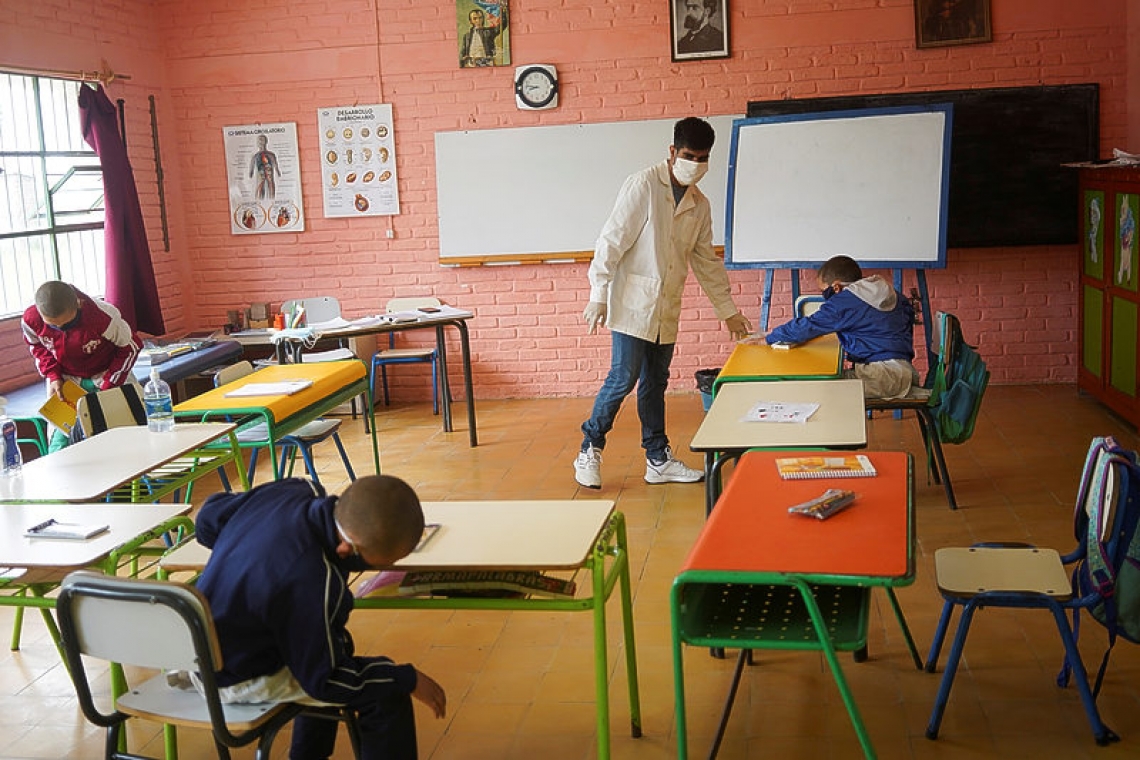BOGOTA--As Colombia enters its eighth week of coronavirus lockdown, street vendor Luis Duarte worries that his teenage daughter might not finish her school year now that her classes have moved online.
"We don't have a computer at home," said Duarte, who sells homemade face masks outside a supermarket in the capital Bogota to earn a living.
"The only internet connection we get is on my smartphone, and that's only when I have data on it. My daughter is missing months of school," he told the Thomson Reuters Foundation.
It's a problem shared across Latin America and the Caribbean, where closures to stem the coronavirus outbreak have left more than 154 million children - about 95% of the enrolled - out of education, many who have no way of going online to learn, according to UNICEF. "There will be for all children significant learning losses, but for those who are vulnerable - for those already at risk - they may never return to school," said Margarete Sachs-Israel, regional education advisor at the U.N. children's agency.
The "digital divide" - the gap between those who have access to computers and the internet, and those with limited or no access - is well documented between rural and urban areas. But quarantine measures around Latin America have also exposed a stark digital divide within the region's big cities - between the people in affluent neighbourhoods and those living in sprawling slums.
"There is part of the population that has no internet access, firstly, because they live in informal settlements where there's no adequate (digital) infrastructure," said architect and urban consultant Ignacio Alcalde, who is based in Madrid.
"And, secondly, because this is a vulnerable population that relies on the informal economy, which doesn't allow for people to pay for access," added Alcalde, a senior associate expert for UN-Habitat, the agency for housing and urban development.
Urban experts are hoping the lockdowns will spur action by authorities to consider an affordable internet connection as a basic right and service, like water and sewage systems, that cities are expected to provide. "Digital connectivity ... it's part of our lives. It can't be that in areas of the city there's no adequate digital connection," he said.
Development Divide
In El Salvador, photos of a university student climbing a tree to get an internet connection so that he could follow online classes went viral on social media in April, prompting President Nayib Bukele to take to Twitter to offer him free internet.
The novel coronavirus pandemic has also exacerbated digital inequality among urban dwellers that goes beyond education. Not having internet access makes it difficult for poor families to access financial aid that many governments are offering to help people survive quarantine, as applying often requires registering online, according to urban experts.
Lockdowns have shown how vital it is for everyone to be connected, whether to buy food, consult with doctors, attend school or stay in touch with each other, said Shamika Sirimanne, head of technology at the U.N.'s trade and development body (UNCTAD). "We thought it would take time to turn a digital divide into a development divide. But COVID-19 has shown us how fast this is becoming a reality," she said in a phone interview from Geneva.
In Latin America, about two-thirds of people have internet access, according to Sirimanne. But that figure masks a vast imbalance between and within countries - ranging from Nicaragua, where 25% of people have internet access, to 80% in Chile, she noted.
Most governments in Latin America already have development plans in place to expand digital infrastructure and get more people connected. In recent decades, tackling the digital divide has largely focused on bringing the internet to rural areas and Wi-Fi tablets into schools, along with free internet in public spaces.
Urban experts now hope the pandemic will prompt governments to address the digital divide in poor city neighbourhoods. They say one key challenge city officials face in getting more people online is bringing down the cost of internet access for the poor, especially in the Caribbean.
"In many countries you see the poorer you are, the more expensive the internet is as a proportion of your monthly income," Sirimanne said.
Basic Right?
Half of the world remains unconnected, and only two out of 10 people in the least developed countries are online, according to the International Telecommunication Union, the U.N.'s internet and telecoms agency. The World Bank has said the ongoing pandemic has shown that connectivity is a "public good".
The outbreak has also prompted local authorities in some countries to get more people online. Earlier this month, Bogota's mayor unveiled a new city development plan that includes connecting 100,000 homes with children to the internet by 2024.
In Brazil's city of Recife, the mayor has pledged to buy 2,500 smartphones for children so they can continue studying during the quarantine. And Sachs-Israel at UNICEF said in Peru, the government is spending $165 million on 850,000 Wi-Fi tablets to allow children to continue learning during the lockdown.
Many countries in the region - including Brazil, Colombia and Argentina - have expanded online learning platforms and digital libraries for children affected by school closures.
Telecoms companies are also playing a role in increasing internet speed and capacity without charging customers. In Peru, for example, the telecom regulator plans to issue a decree prohibiting the suspension of services for non-payment, according to the World Bank.
But in many countries, internet access is still seen as "luxurious infrastructure", said Sirimanne. "For us (the UNCTAD), connectivity is equally a priority and now we see why. We hope governments will wake up to this reality after COVID-19."







